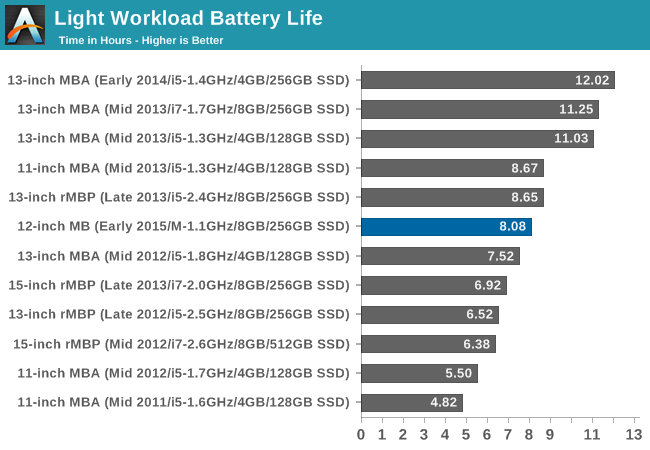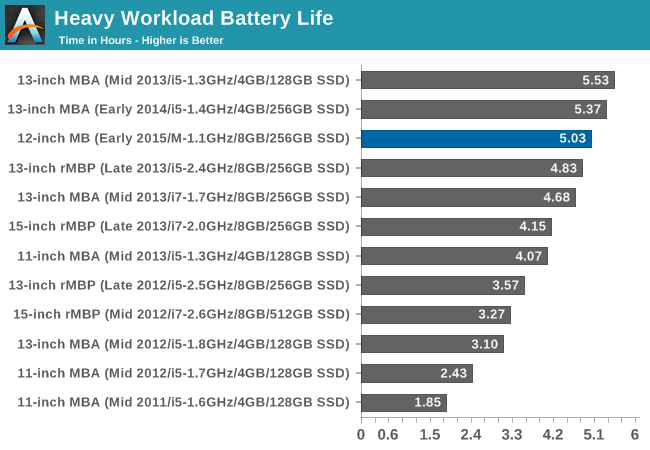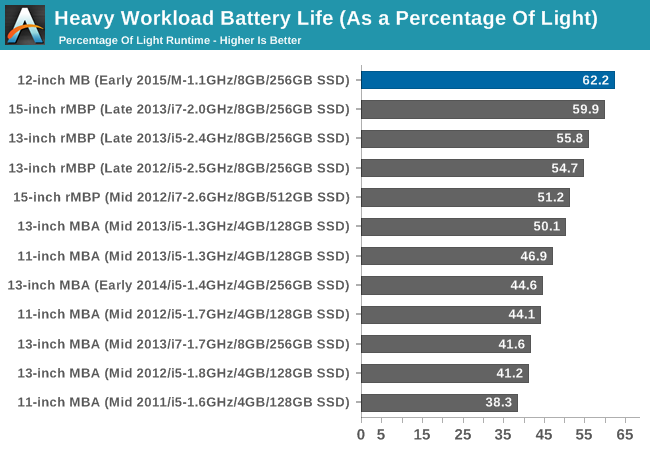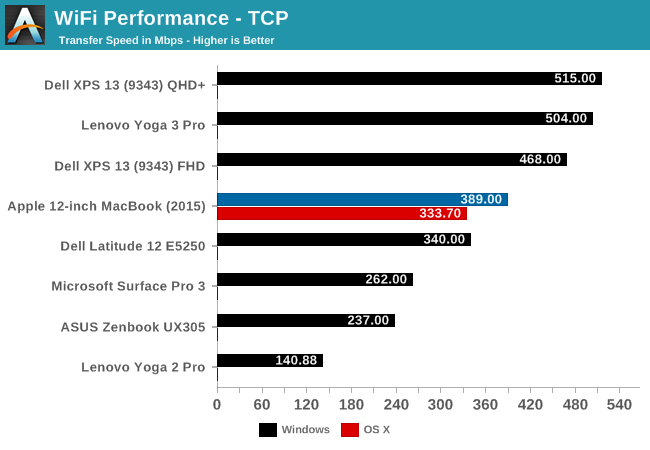The 2015 MacBook Review
by Ryan Smith on April 14, 2015 10:15 AM ESTBattery Life & WiFi Performance
Last but certainly not least in our look at the MacBook is a look at its battery life and WiFi performance.
Along with the technical considerations that have gone into making the MacBook as small as it is, I would consider the subject of battery life to be the second most interesting aspect of the MacBook’s design. For on the one hand, the CPU at the heart of this laptop is Core M, a very low power CPU specifically designed for thin & light devices, which on its own doesn’t draw all that much power. On the other hand in constructing the MacBook Apple has ditched the MacBook Air’s standard DPI TN panels for high DPI Retina IPS panels. As we’ve seen in other Apple products in the past, going Retina incurs a significant power cost, as the high DPI displays require a much stronger, much more power hungry backlight to light up the display. Apple needs only to pay this cost once, but it’s an expensive cost.
All the while Apple also has to deal with the battery capacity limits of such a small chassis. Using terraced batteries has allowed Apple to maximize the amount of volume the MacBook’s batteries occupy, however at 39.7Wh this only gets them up to roughly where the 11” MBA (38Wh) already sat. The end result is that relative to the 11” MacBook Air Apple has virtually the same battery capacity to drive a less power-hungry CPU and logic board paired with a more power-hungry display.
Officially the MacBook should be able to hit 9 hours of runtime on a light web workload, and 10 hours with video playback. This happens to be identical to what the 11” MacBook Air is rated for, and in practice would be very close to what the Haswell-based 11” Airs hit as well.
Meanwhile to test battery life, we have two workloads. Our light test is light web browsing, and our heavy test increases the number of pages loaded, adds a 1 MB/s file download, and has a movie playing. We set all displays to 200 nits.

In practice what we find is that by our testing methodologies the MacBook falls about an hour short, clocking in at 8 hours and 5 minutes. The difference in battery life most likely comes down to differences in how we test; Apple bases their estimates on 75% display brightness, whereas we test at 200 nits, which in the case of the MacBook is around 85% brightness. If we turned our brightness down to 75% I suspect our results would come very close to Apple’s, at the cost of dropping below 200 nits of brightness.
Even by our own testing standards, the MacBook’s battery life is enough to get the laptop through an entire work day (8 hours) – if only just – so while we can’t hit 9 hours at our preferred brightness Apple isn’t in too poor of a position for such a small laptop. In practice what this means is that the MacBook does just a bit worse than the 11” MacBook Air, essentially falling behind by 40 minutes of runtime. However given the fact that the MacBook is also physically smaller than the 11” Air, this is not an unexpected tradeoff.
Putting things in a bit larger perspective, thanks to Intel’s massive energy efficiency gains from Haswell in 2013, the MacBook looks very good compared to the older 2011/2012 11” MacBook Air models. From a battery life perspective the new MacBook easily exceeds those models, is physically smaller than those models, and all the while delivers performance that at worst is equivalent and at best better than those models. Put another way, Apple has been able to hold performance constant while bringing down both the size and greatly improving the battery life.
However if you want better than 8 hours on a light workload, then even the MacBook is no substitute for a larger laptop with a bigger battery. There’s only so much that can be done on 39.7Wh, and as a result the 13” MacBook Air will remain unmatched as Apple’s long-haul Ultrabook.

Meanwhile with a heavy workload the MacBook’s fortunes improve. No longer just in the middle of the pack, at 5 hours and change it’s offering runtimes close behind the 13” MacBook Airs. This shift in relative performance is not unexpected, and is closely tied to the balance between CPU power consumption and display power consumption. Compared to the light workload, the heavy workload requires that the CPU draw quite a bit more power all the while the amount of power drawn by the display is virtually unchanged. As a result the higher powered MacBook Airs see a big step up in their power requirements, while the Core M equipped MacBook sees a smaller step up.

In fact if you look at heavy workload runtime as a percentage of light workload runtime, the 2015 MacBook has the smallest drop in runtime out of all of the MacBooks. Apple’s latest laptop gets 62.2% of its light runtime under the heavy workload, compared to 50.1% for the best MacBook Air. The only thing with a similarly small decrease are the Retina MacBook Pros, whose large, Retina displays result in a similar situation.
Somewhat paradoxically then, the MacBook looks best under a heavy workload, even though its processor is relatively slow. Ultimately this is more an intellectual curiosity than anything else, but it’s a great example of how the MacBook’s component selection has resulted in a much different power consumption balance between the display and CPU than what we’ve seen on the MacBook Airs and similar Ultrabooks. If the display isn’t the single biggest power draw on the MacBook, it’s certainly going to be a close second.
WiFi Performance
Our final benchmark is a quick glance at WiFi performance. The MacBook ships with a Broadcom 2x2:2 802.11ac solution, which means that in theory it is capable of delivering up to 833Mbps.
For our WiFi benchmark we copy a large file from a Gigabit Ethernet connected SMB file server, timing how long it takes to transfer the complete file and calculating the average. All laptops are placed within a few feet of the router to maximize their achievable bandwidth and minimize interference. For the MacBook we’ve gone ahead and run this test under both Windows and OS X, to showcase any performance differences between the two OSes.

Under Windows the MacBook hits 389Mbps, about 47% of its theoretical maximum performance. Compared to other Windows laptops this is a mixed bag, with some laptops able to hit as high as 500Mbps, and others coming up much shorter. In the case of the MacBook I suspect the all-aluminum chassis is not doing it any favors. Meanwhile performance under OS X is a bit worse at 333.7Mbps, most likely due to OS X’s less extensively optimized SMB support.
While I imagine it’s impractical from a design perspective, given the fact that the MacBook only has a single USB port, I would have liked to see a 3x3:3 solution for the MacBook to allow it to achieve better WiFi performance. Even 3x3 solutions seldom keep up with GigE in the real world, but the MacBook certainly has the SSD and processing power to handle faster speeds than what we’re seeing here.










354 Comments
View All Comments
ws3 - Tuesday, April 14, 2015 - link
Charge when you aren't using any external device, don't charge when you are. Charge overnight every night.I understand that this pattern doesn't fit everyone's needs but this product is not meant for people who truly require multiple things plugged in at a time that is obvious. If you are such a person, buy a different product.
People who don't need to plug in multiple things at the same time and people who only think they need to plug in multiple things at the same time may be well served by this product.
As for Jobs, this product is exactly what he dreamed of. He hated fans and he hated ports. He'd probably like it even better if it had zero ports.
repoman27 - Tuesday, April 14, 2015 - link
Aside from implementing a lot of brand new specs, this is just a standard USB charging port though. Get a USB hub that supports BC 2.0 passthrough from Monoprice or whoever in a month or two and you're all set. A simple y-adapter cable that allows power in for charging and DisplayPort out could probably be sold for $15.These are easily solvable problems.
repoman27 - Tuesday, April 14, 2015 - link
Sorry meant PD, not BC.darwinosx - Tuesday, April 14, 2015 - link
There are already cables that allow this.nyoungman - Tuesday, April 14, 2015 - link
When the MacBook Air was first introduced it only had one USB port. Now it has two.It will be curious to see how this develops in the next iteration or two, esp. since Apple acquired Beats, and they make wireless headphones.
joscha - Tuesday, April 14, 2015 - link
Why do you keep insisting that this is somehow a tablet? Apple had a 12in laptop ten years ago. This thing has no A7 processor, no iOS, no touch screen. Standard sized keyboard, touchpad, OS X.This is just a normal Macbook with big dongles, aimed at early adopters that can live with slightly limited memory, harddisk and speed.
Klug4Pres - Tuesday, April 14, 2015 - link
I agree. I fail to see the likeness of this device to a tablet.ws3 - Tuesday, April 14, 2015 - link
It's like a tablet in that it has a single port, low power processor with passive cooling, and has adopted the iPad color scheme. Ryan didn't claim anything more that that.TEAMSWITCHER - Tuesday, April 14, 2015 - link
It's also thin, light, and easily carried. I switched to an 11" MacBook Air with a Brenthaven sleeve. When people see it, they assume it's an iPad. Until I take it out and *SURPRISE* it's a MacBook. I imagine this new MacBook will generate an even bigger reaction.Alexey291 - Thursday, April 30, 2015 - link
"Surpise its macbook" more like surprise its a tablet without a touchscreen xD